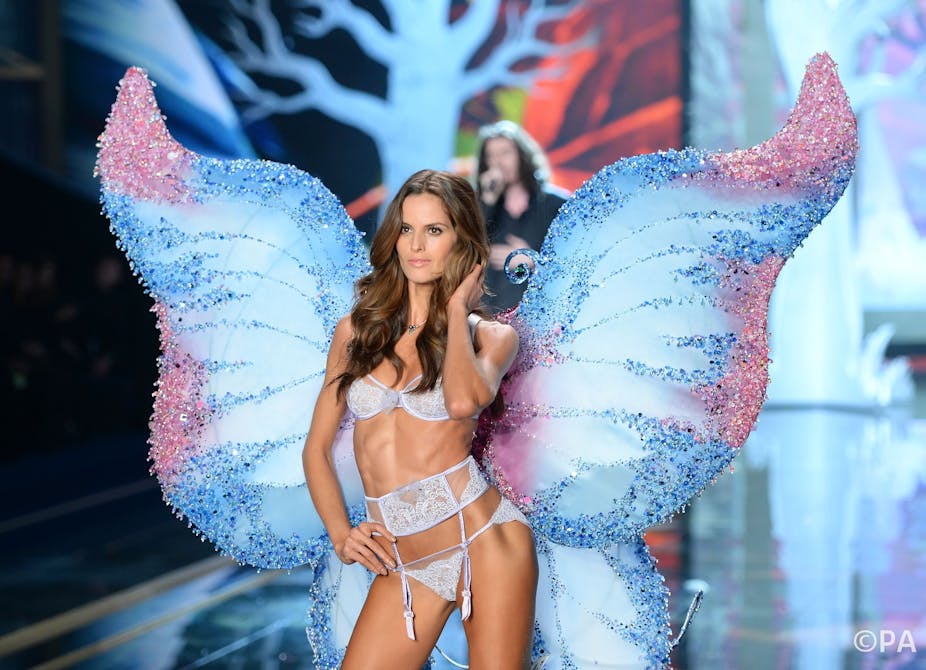London has just experienced a fashion show quite unlike any other, despite its long history as one of the world’s four fashion capitals. Victoria’s Secret, for those who are unacquainted, is an underwear empire that had sales of US$6.6 billion in 2013. But the show’s focus was not lingerie, but rather the models – known as Victoria’s angels.
Accordingly, the brand produces spectacular shows each year, which are later televised with a viewing figure of millions (if you’re keen, tune in on December 9 in the US and December 10 in the UK). This year, Victoria’s Secret arrived in London.
Spectacular shows are nothing new in fashion. Rarely failing to thrill, Karl Lagerfeld’s are eagerly anticipated each season. He transported a nine-metre high iceberg to Paris from Sweden for his autumn/winter 2010/11 ready-to-wear show for Chanel, a cruise collection was shown on a private island off the coast of Dubai and in 2007 he produced a show for Fendi on the Great Wall of China.
Christopher Bailey’s creative vision for Burberry has involved harnessing the latest technology to produce fantastical productions, including a party in Beijing to celebrate the launch of its flagship store – with hologram models. They shattered into a sprinkling of magical dust on the runway as live catwalk met virtual images. Beautifully choreographed, it was hypnotic to watch.

Extravaganza
London’s Victoria’s Secret show may well have been as spectacular as those of Lagerfeld and Bailey – and equally expensive at a reputed US$12m, but the focus is not the same. Most obviously, the models are wearing far fewer clothes than the average catwalk show, and very little focus is on these clothes.
So is this fashion, or a theatrical panoply, boasting singers, dancers and sexualised imagery? The interaction between the stars on the catwalk, the music and the spectacle certainly mean that the show angles itself towards contemporary popular entertainment.
Fashion shows are one of the industry’s most powerful marketing tools. The fashion show can communicate a dream, a story, a fantasy – and can do so in a manner that generates huge media excitement. Victoria’s Secret looks to a different audience than Chanel, and the fashion show mutates accordingly. And the underwear empire communicates its particular dream spectacularly well.

So what is the dream? The main focus for Victoria’s Secret is the celebrity models. There were more than 40 at this year’s event, carefully selected for their personality and their ability to act as much as for their looks (a homogenous collection of tall, thin models with full busts). They are known as “angels” because of the dramatic wings they wear as they walk the runway, interacting with equally famous musicians – this year Taylor Swift – who perform on the catwalk. It could easily be likened to a West End musical.
The girl next door
The point of putting on this supremely extravagant show is to get the audience to relate to the models. So “video packages” about the models are posted on the internet in the run up to the show to give the consumer this sense, presenting them as the girl-next-door with some celebrity sparkle. Footage of the run-up to the event, backstage videos and further documentation also add a reality TV feel of the build-up.
Then there’s the finale, when celebrity models in skimpy lingerie stalk down the catwalk with A-list musicians, also dressed for the occasion – unsurprisingly garnering considerable press attention and a viewing figure of millions when televised.
The show is highly sexualised and has in the past been criticised as pornographic. But then how could this be pornography when the “angels” wear wings and are just a group of wholesome, fun, girl-next-door personalities playfully partying on the catwalk?
The show comes just over a month after the company was criticised in the UK for its latest bra advertising campaign, which portrayed the words “The Perfect Body” superimposed over a line-up of thin models in underwear. The company replaced this with “A Body for Everybody” after a petition was signed by thousands of people.

This is the company’s first show in London, and its second in Europe, a part of the world with a very different fashion aesthetic from that in the US. Europe is where Jean Paul Gaultier regularly shows his bridal gowns on transgender models, Nick Knight of fashion website SHOWstudio shoots pin-ups featuring images that play with and subvert the traditional motifs of erotic clothing – and Agent Provocateur promotes its highly erotic lingerie on the catwalk in aid of a charity about empowering women.
Fashion is about change, about breaking rules, about the “new” – and London in particular is famous for its innovation and its experimental fashion. Virtually indistinguishable from the company’s previous events, and sticking to the well-worn “girl-next-door” stereotype, this year’s show was, therefore, strangely at odds with the city’s fashion zeitgeist.

